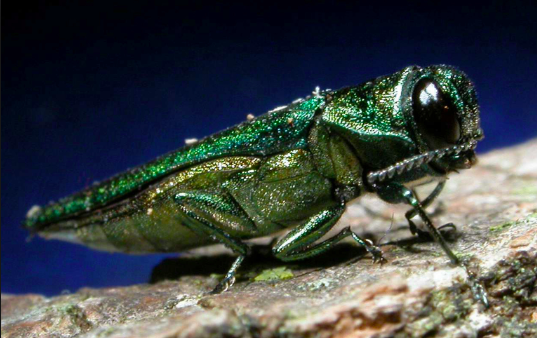
Don’t be fooled by its beautiful green coat, the Emerald Ash Borer (EAB) is a menace that is wiping out ash trees in thirty-five states one way or another. The Washington Post reported that “Loggers in snowy forests are cutting down ash trees like there’s no tomorrow, seeking to stay one step ahead of a fast-spreading beetle….” Some areas have only a few years of trees left to log, while others are even more hard hit — ash trees are wiped out in Maryland and southern Pennsylvania. According to the Emerald Ash Borer Information Network:
- It is an “exotic” invasive beetle species that was discovered in the summer of 2002 near Detroit, Michigan.
- The adult beetles nibble on ash foliage but cause little damage — it is the larvae that are so destructive — they feed on the inner bark of ash trees, which then destroys the tree’s ability to transport water and nutrients.
- It is native in Asia and most likely came to the U.S. on solid wood packing material carried in cargo ships or airplanes.
- It is now found in 35 states, and across Canada in the provinces of Ontario, Quebec, New Brunswick, Nova Scotia, and Manitoba.
Experts say that the Emerald Ash Borer leaves few surviving trees and there is nothing to stop its continued killing spree — states that have not yet been infested are on guard. As a result, ash trees in many states are being cut down quickly so that at least their wood can be used before it is destroyed — some mills are sawing ash trees at about double the rate of the past. George Robinson, a University at Albany biology professor and a member of the state Invasive Species Advisory Committee, told The Post that he doesn’t think the ash trees will be entirely wiped out. But they’ll be greatly reduced. “The hope,” he said, “is by collecting seeds and some specimens there will be a future for the ash.”
Why This Matter: Interestingly, the Agriculture Department (USDA) reports that there is growing evidence that the extremely cold temperatures of recent weeks caused by the dip in the polar vortex into the lower 48 may be providing a reprieve from the EAB. “Research conducted by the USDA Forest Service showed that nearly 70 percent of EABs were killed off. But the USDA warns that there is still 30 percent or so that are very destructively alive so the problem will continue.” That is a small silver lining and a reminder that climate change is unpredictable in its impacts. Still, there is also reason to believe that some areas in the far north may be more susceptible to these monster beetles in the future. Most disappointing to us is that the Washington Post only published this story on its Kids Post page — did they think only kids would care about a killer beetle?
March 1, 2019 » ash, beetle, forest, invasive species, logging, USDA


